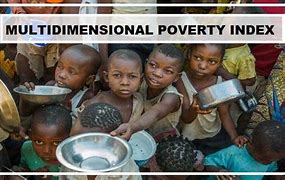Context:
Recently, the Global Multidimensional Poverty Index (MPI) 2024 was published in the annual report released by the Oxford Poverty and Human Development Initiative (OPHI) and the United Nations Development Programme (UNDP).
More on the news
- The 2024 report theme is “Poverty Amid Conflict”.
- The Global Multidimensional Poverty Index (MPI), 2024 uses the most recent comparable data available for 112 countries—21 low-income countries, 47 lower-middle-income countries, 40 upper middle-income countries and 4 high-income countries.
- It examines the relationship between violent conflict and multidimensional poverty across countries and over time.
Key findings of report:
- Across 112 countries and 6.3 billion people, 1.1 billion people (18.3 percent) live in acute multidimensional poverty (referred to as “poverty” throughout this report).
- Nearly 40% of the 1.1 billion poor (455 million) live in countries exposed to violent conflict, hindering and even reversing hard-won progress to reduce poverty.
- Over half of the 1.1 billion poor (584 million) people are children under the age of 18.
- Of 86 countries with harmonized data, 76 significantly reduced poverty according to the MPI value in at least one time period.
The five countries with the largest number of people living in poverty are India (234 million), which is medium Human development Index (HDI), and Pakistan (93 million), Ethiopia (86 million), Nigeria (74 million) and the Democratic Republic of the Congo (66 million), all low HDI.
- Together, these five countries account for nearly half (48.1 percent) of the 1.1 billion poor people.
About Global MPI:
Launched: 2010
The MPI captures various aspects of poverty, including Education, Health and living Standards, through ten specific indicators.
- Each dimensions share 1/3rd Weight individually.
- If a person is deprived in a third or more of ten (weighted) indicators, the global MPI identifies them as ‘MPI poor’.
This multidimensional approach provides a more nuanced understanding of poverty compared to solely income-based measures.
The MPI is denoted as MPI = H x A. MPI values range from 0 to 1, and higher values imply higher poverty.
- Headcount Ratio (H): The percentage of multidimensionally poor people, and
- Intensity of poverty (A): The average level of deprivation among the poor.
The global MPI advances Sustainable Development Goal (SDG) 1, ending poverty in all its forms everywhere, and measures interconnected deprivations across indicators related to SDGs 1, 2, 3, 4, 6, 7 and 11.

National Multi-dimensional Poverty Index (NMPI):
- India’s NMPI was introduced in 2021 which was released by the Niti Aayog, in collaboration with UNDP and the Oxford Poverty and Human Development Initiative (OPHI).
- It identifies the poor and non-poor based on a dual-cut-off counting method.
- The National MPI can be used monitor multidimensional poverty at the national, state, and district levels in India.
- India’s National MPI aligns with Sustainable Development Goal 1.2, which aims to reduce the proportion of people living in poverty in all dimensions by at least half by 2030.
- Indicators: It has 3 dimensions viz. Health, Education and Standard of Living and 12 indicators. (10 original indicators of the global MPI model and two new indicators, viz., Maternal Health and Bank Account.)

Also Read:
Unique Drug Delivery Method to Improve Treatment of Brain Tuberculosis

